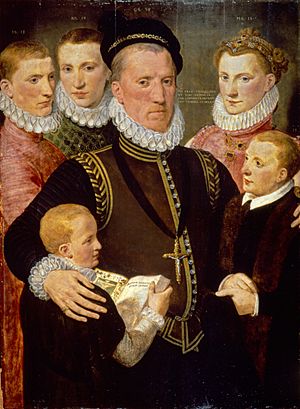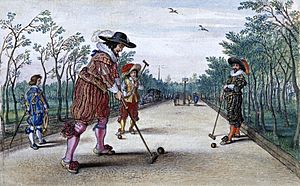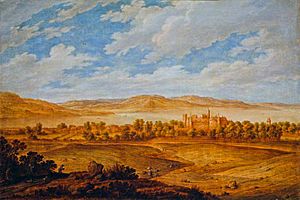Seton Palace facts for kids
Seton Palace was a beautiful and important building located in East Lothian, Scotland. It was just a few miles south-east of Edinburgh, close to the town of Prestonpans. Many people thought it was the most impressive home in Scotland during the 1500s and 1600s. The palace was first built in the 1400s by George, 4th Lord Seton.
By the 1500s, the palace belonged to the Lords Seton. It was a favorite place for Mary, Queen of Scots to visit. She even spent her honeymoon there with Lord Darnley in July 1565. Mary enjoyed playing golf at Seton. People said she played "pall-mall and golf." "Pall-mall" was an early game similar to croquet. In the 1600s, the palace had a unique triangular shape with three sections built around a central courtyard.
Contents
The Early History of Seton Palace
It's not exactly clear when Seton Palace was first built. It stood on the lands of Seton and Winton. A book called History of the House of Seytoun by Richard Maitland tells us some things about the building. He wrote that George Seton, 5th Lord Seton (who died in 1513) finished a part called the "jemmay house." His grandfather, John, Master of Seton, had started building it. George's wife, Janet Hepburn, Lady Seton, then built the front entrance or gatehouse.
Seton Palace and the English Invasion
Sadly, an English army burned the palace on May 16, 1544. This happened after the English also burned Edinburgh. The English commander, Lord Hertford, wrote that Lord Seton was nearby. Lord Seton could see his own home and town burning. Lord Seton was married to a French lady named Marie Pieris. Their daughter, Mary Seton, was a close friend and companion of Mary, Queen of Scots.
Restoring the Palace and Royal Visits

After the fire, the main tower and the "jemmay house" were rebuilt. This was done by Sir William Hamilton of Sanquhar. He was the Captain of Edinburgh Castle and the father-in-law of George Seton, 7th Lord Seton. A walled garden was also built around this time. The old main tower fell down in 1561, but new windows were added to the structure. Janet Hepburn's gatehouse was almost completely rebuilt too.
Mary, Queen of Scots, visited Seton Palace often. In January 1562, New Year's Day was celebrated there. A poet named Alexander Scott wrote a poem for her. It was called Ane New Yeir Gift to Quene Mary and gave her advice on how to rule Scotland fairly.
More Royal Guests and Palace Features
In 1584, a visitor named Lupold von Wedel admired the tall hedges in the garden. He couldn't get inside to see them up close. King James VI stayed at Seton Palace in September 1589. He was waiting for Anne of Denmark to arrive in Scotland, but she didn't come then. The English ambassador, Lord Burgh, enjoyed a big meal there on February 24, 1593. On May 31, 1597, Anne of Denmark traveled to Seton in a special chair, even though it was raining. King James VI visited Seton again on May 15, 1617. The poet William Drummond of Hawthornden presented his poem Forth feasting to the King there.
Historical records show that Seton Palace was the most magnificent palace in Scotland in the 1600s. Alexander Nisbet described some of the inside details. Above the fireplace in the Great Hall, you could see the Seton family's coat of arms. It was surrounded by a collar that Nisbet thought represented the Order of the Thistle. Another room, called "Samson's Hall," had 28 coats of arms on its ceiling. These belonged to important families from France, Scotland, and Lorraine. They were "curiously embossed and illuminated," meaning they were raised and brightly painted. Viscount Kingston remembered seeing a painting on a wall in the Long Gallery. He believed it showed the 7th Lord Seton driving a wagon. This was during his time living in France after Mary, Queen of Scots, gave up her throne.
The Gardens of Seton Palace

Even though it was near the sea, the gardens at Seton Palace were full of different trees. There were sycamores, walnut trees, apple trees, and other fruit trees. There would have been a grassy area or court for playing pall-mall, just like Mary, Queen of Scots did in 1567. King James VI even suggested the game for his son, Prince Henry, in his book Basilikon Doron.
The gardens also grew strawberries in July. There's a story that one of the gardeners in the 1500s had a son who became a pirate. He came back and gave the Earl of Winton a rare seashell. It was a turbo pica from the West Indies. The Earl had it turned into a snuff box with a silver lid by a famous goldsmith named George Heriot.
The Palace Falls to Ruin
The Seton family, who later became known as the "Earls of Winton," lost their lands after the Jacobite rising of 1715. This was a rebellion where people tried to bring back the old royal family. The palace was burned during this uprising. By 1780, it was described as being in ruins.
Seton Castle is Built
Seton Palace was completely torn down in 1789. That same year, the owner of the land, Lt Col Alexander Mackenzie, hired a famous architect named Robert Adam. Adam built a new grand house called Seton Castle on the site. Some of the stone from the old Seton Palace was used to build the new castle.
Today, some of the walls from the famous formal gardens of the 1500s and 1600s still remain. You can see round lookout towers at the corners of these old garden walls.
Images for kids
-
George Seton, 7th Lord Seton and his children in 1572. This painting shows Margaret, Lady Paisley, Robert, Earl of Winton, Sir John Seton of Barns and Alexander, Earl of Dunfermline.
-
A drawing of a game of pall-mall being played by Frederick V of the Palatinate and Frederick Henry, Prince of Orange around 1625.





